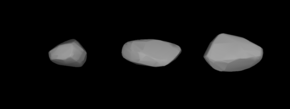 A three-dimensional model of 265 Anna based on its light curve A three-dimensional model of 265 Anna based on its light curve | |
| Discovery | |
|---|---|
| Discovered by | Johann Palisa |
| Discovery date | 25 February 1887 |
| Designations | |
| MPC designation | (265) Anna |
| Pronunciation | /ˈænə/ |
| Named after | Anny Weiss |
| Alternative designations | A887 DA, 1933 QN 1933 RC |
| Minor planet category | Main belt |
| Orbital characteristics | |
| Epoch 31 July 2016 (JD 2457600.5) | |
| Uncertainty parameter 0 | |
| Observation arc | 115.71 yr (42263 d) |
| Aphelion | 3.06672 AU (458.775 Gm) |
| Perihelion | 1.77398 AU (265.384 Gm) |
| Semi-major axis | 2.42035 AU (362.079 Gm) |
| Eccentricity | 0.26706 |
| Orbital period (sidereal) | 3.77 yr (1375.4 d) |
| Mean anomaly | 84.9293° |
| Mean motion | 0° 15 42.3 / day |
| Inclination | 25.6443° |
| Longitude of ascending node | 335.566° |
| Argument of perihelion | 251.567° |
| Physical characteristics | |
| Dimensions | 23.66±3.0 km |
| Synodic rotation period | 11.681 h (0.4867 d) |
| Geometric albedo | 0.1045±0.033 |
| Absolute magnitude (H) | 11.9 |
265 Anna is a typical Main belt asteroid.
It was discovered by Johann Palisa on 25 February 1887 in Vienna and was probably named after Anny Weiss (née Kretschmar), the daughter-in-law of astronomer Edmund Weiss.
References
- Noah Webster (1884) A Practical Dictionary of the English Language
- "265 Anna". JPL Small-Body Database. NASA/Jet Propulsion Laboratory. Retrieved 11 May 2016.
- Schmadel, Lutz (5 August 2003). Dictionary of Minor Planet Names. Springer Science & Business Media. ISBN 9783540002383 – via Google Books.
External links
- The Asteroid Orbital Elements Database
- Minor Planet Discovery Circumstances
- Minor Planet Lightcurve Parameters
- 265 Anna at AstDyS-2, Asteroids—Dynamic Site
- 265 Anna at the JPL Small-Body Database

| Minor planets navigator | |
|---|---|
| Small Solar System bodies | |||||||
|---|---|---|---|---|---|---|---|
| Minor planets |
| ||||||
| Comets | |||||||
| Other | |||||||
This article about an asteroid native to the asteroid belt is a stub. You can help Misplaced Pages by expanding it. |